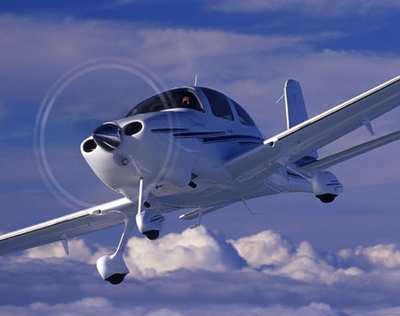Tue, Apr 19, 2011
Had Been Accused Of Inadequately Training New Pilots
An appeals court in Minnesota has overturned a ruling against
Cirrus Design which had held the company responsible in the deaths
of two people fatally injured in an accident involving an SR22.

2003 SR22 File Photo
Gary Prokop and James Kosak were fatally injured in January,
2003 when the SR22 Prokop was flying went down in instrument
conditions for which he was not rated. Court documents indicate
that, prior to purchasing the Cirrus, Prokop had accumulated some
225 hours of flight time, mostly in his personal Cessna 172. He was
in the process of obtaining an instrument rating. The NTSB found
that the probable cause of the accident was "Spatial disorientation
experienced by the pilot, due to a lack of visual references, and a
failure to maintain altitude. Contributing factors were the pilot's
improper decision to attempt flight into marginal VFR conditions,
his inadvertent flight into instrument meteorological conditions,
the low lighting condition (night) and the trees." The accident
occurred in the early morning hours in January. The lawsuit said
that Cirrus was negligent because Prokop had not been properly
trained in how to engage the autopilot, which could have helped him
fly out of the marginal conditions. The jury agreed, and had
awarded a total of $16.4 million to the families of the two
men.
Minnesota Public Radio reports that the appeals court found that
Cirrus had fulfilled its legal responsibility to warn owners about
the risks involved in flying, and that instructions in the POH
covering autopilot use were sufficient. In the ruling released
Tuesday, the court found that "although proficiency training
undoubtedly promoted the safe use of the SR22 (model of airplane),
we find no support in the law for (the) proposition that Cirrus's
duty to warn included an obligation to train Prokop to proficiently
pilot the SR22."

"Because an airplane manufacturer's duty to warn of dangers
associated with the use of its aircraft does not include a duty to
provide pilot training," the decision continues, "respondents'
negligence claims cannot be sustained under a product-liability
theory. Moreover, because the claims sound in educational
malpractice, they are barred as a matter of law."
MPR indicates that one justice disagreed with the majority,
saying that Cirrus had "voluntarily assumed a duty to provide the
promised training."
More News
Aero Linx: Transport Canada We are a federal institution, leading the Transport Canada portfolio and working with our partners. Transport Canada is responsible for transportation p>[...]
Gross Navigation Error (GNE) A lateral deviation from a cleared track, normally in excess of 25 Nautical Miles (NM). More stringent standards (for example, 10NM in some parts of th>[...]
From AirVenture 2017 (YouTube Edition): Flight-Proven Booster On Display At AirVenture… EAA AirVenture Oshkosh is known primarily as a celebration of experimental and amateu>[...]
Aircraft Parachute System (CAPS) Was Deployed About 293 Ft Above Ground Level, Which Was Too Low To Allow For Full Deployment Of The Parachute System Analysis: The day before the a>[...]
Also: 48th Annual Air Race Classic, Hot Air Balloon Fire, FAA v Banning 100LL, Complete Remote Pilot The news Piper PA-18 Super Cub owners have been waiting for has finally arrived>[...]
 ANN's Daily Aero-Linx (06.29.25)
ANN's Daily Aero-Linx (06.29.25) ANN's Daily Aero-Term (06.29.25): Gross Navigation Error (GNE)
ANN's Daily Aero-Term (06.29.25): Gross Navigation Error (GNE) Classic Aero-TV: Anticipating Futurespace - Blue Origin Visits Airventure 2017
Classic Aero-TV: Anticipating Futurespace - Blue Origin Visits Airventure 2017 NTSB Final Report: Cirrus SR22
NTSB Final Report: Cirrus SR22 Airborne Affordable Flyers 06.26.25: PA18 Upgrades, Delta Force, Rhinebeck
Airborne Affordable Flyers 06.26.25: PA18 Upgrades, Delta Force, Rhinebeck




